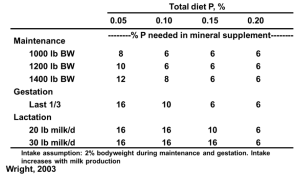Justin Waggoner, Ph.D., Beef Systems Specialist
It can be challenging to select a mineral program, as there are many different products and mineral formulations currently available. When evaluating mineral supplements the phosphorous concentration may be used as guide to determine if the mineral fits the production stage of the herd and forage base. Phosphorous is one of the most common mineral deficiencies in grazing systems around the world and is one of the primary reasons we provide mineral supplements to grazing beef cattle. The table below illustrates the amount of phosphorous required in a mineral supplement required for cattle at various production stages consuming forages with different phosphorous concentrations. Forage phosphorous concentrations vary and are typically greatest during the spring and lowest in the winter. In Kansas, phosphorous content of native range in the spring is typically between 0.15 and 0.20%. Thus, the maintenance requirements of lactating cow (20 lbs milk/d) could be met by a mineral with at least 8% phosphorous (average of 6 and 10 in the table).
For more information, contact Justin Waggoner at jwaggon@ksu.edu.
